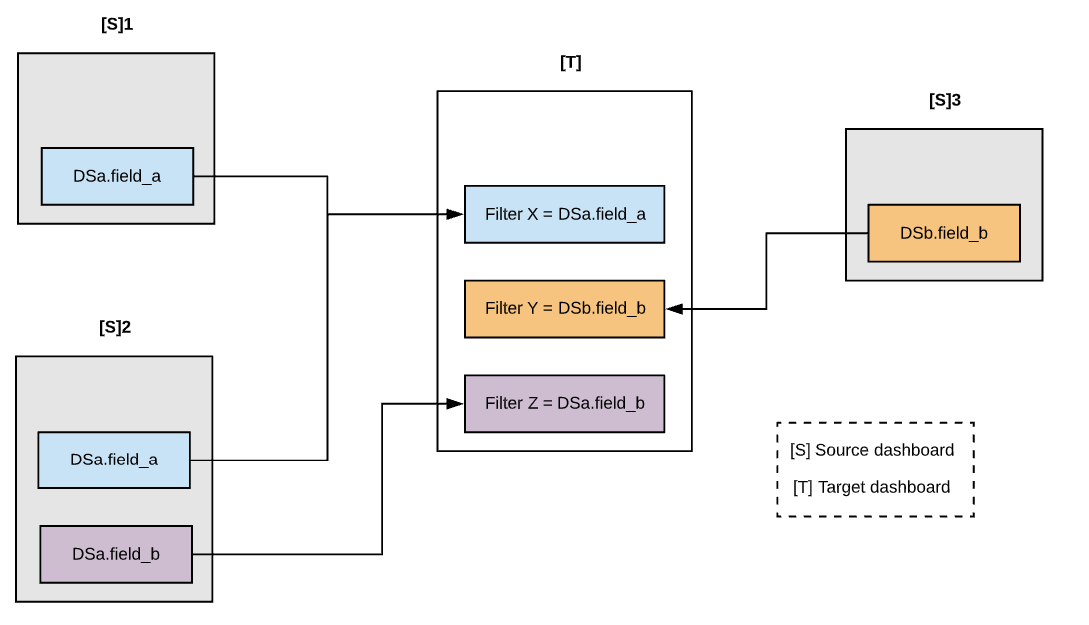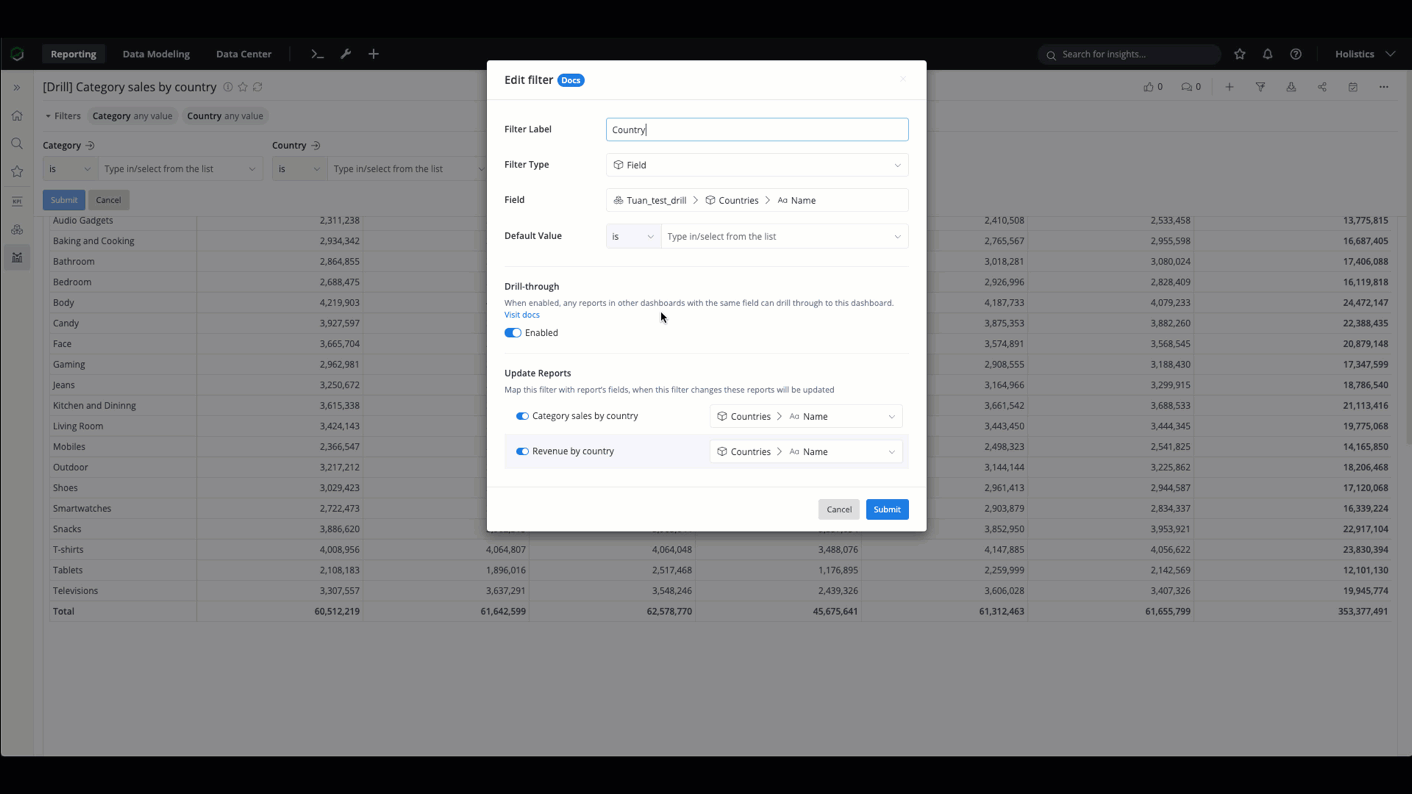Drill-through
A grasp of these concepts will help you understand this documentation better:
If you have any questions or feedback regarding drill-through, let us know by filling in this form! We'll get back to you asap.
Introduction
In Holistics, Drill-through allows viewers to explore additional data related to one or more data in the original report.
For example, we are looking at the total revenue of the T-shirt in New York. We might wonder what the customer demographic and their contact info are. With drill-through, we can easily navigate to that data with a click.

Mechanism
In Holistics, drill-through is the process of linking many source dashboard [S] to one target dashboard [T] that contains information relevant to all the sources.
- Source dashboard: the dashboard that contains the generic data that we want to explore further. In our example, the
Category analysisdashboard is the source dashboard, the generic data is the revenue of New York. - Target dashboard: the dashboard that contains more specific information that provides us with a more detailed understanding. In our example, the
Customer Demographicsdashboard is the target dashboard, the customer emails, age groups, and gender distribution are detailed information.
Technically, we are creating a filter (Filter X, Y, Z) at the target dashboard that can take the value of any field (field_a, field_b) from any dataset (DSa, DSb)

Then, whenever we want to drill through from any source dashboard (that contains those fields), we will be navigated to the target dashboard where that field's value is applied as a filter (Filter X = DSa.field_a, Filter Y = DSb.field_b, Filter Z = DSa.field_b)
For example:
- We create a filter of Category Name and City Name at the target dashboard
Customer Demographicso that they can take the value of T-Shirts (as category) and New York (as city). - When we click on the revenue column of T-shirts in New York from
Category Analysis, we will navigate to the dashboard that contains customer demographics and information that buys T-shirts in New York.

Setting up Drill-through
Before you set up drill-through, you should determine the source dashboard that you want to drill from, and the target dashboard that you want to drill through to.
In our example, we have a Category Analysis dashboard that contains the total sales revenue by year and by city. This is our target dashboard.

On the other hand, our source dashboard is Category revenue by country

Set up drill-through at the target dashboard
1. On the target dashboard Category Analysis, select Add Filters, and create a filter with the field Category Name. In Update Reports, select the widgets that you want to apply the filter to.
Since we want to apply category T-shirts to both widgets, we will select both of them.

We are doing this so that when we click on the revenue field of Category T-shirts in Category revenue by country, we will be able to navigate to Category Analysis with filter Category Name = T-shirts
2. In Enable drill-through, toggle on. After you complete this step, you can start drilling through from any widget (in any dashboard) that contain the field Category.

At the moment, Holistics only supports fields that belong to the same dataset and has Field Type equals to Field. Therefore, if we change Field Type from Field to other types, it will automatically disable drill-through. To resolve this, simply change the Field Type to Field, then you can toggle drill-through on.

3. Repeat this in other target dashboards.
Suppose that when you are looking at sales revenue by city, you notice one that is under-performing. You might want to explore the Customer Demographics of that city to find customer's contacts, so that you can launch a segmented marketing campaign to boost sales.
Now, the dashboard Category Analysis becomes a source dashboard and the dashboard Customer Demographic becomes a target dashboard.
We will repeat all the above steps at the target dashboard. Since you want to see the Customer Demographics of people who bought T-shirts and are in a certain city, you will need to set up two filters at Customer Demographics dashboard: Category Name and City Name.
Use drill-through from the source dashboard
Now that you have enabled drill-through for filter Category at target dashboard, let's try drilling from the source dashboard Category revenue by country
1. At dashboard Category revenue by country, right-click on any field that relates to Category T-Shirts. Choose Drill-through, then click on Category Analysis. A pop-up opens, showing you a dashboard of Category analysis with Category = T-Shirts.

T-shirts, despite being one of the top performers when it comes to revenue, actually has its sales going down in recent years.
2. You see that Medan is performing slightly more poorly than other cities. Right-click on Medan's column to drill through one more time. You will navigate to the Customer Demographic dashboard where Category = T-shirts and City = Medan are applied as filters.

3. Click the left arrow button (←) to go back to the previous Category Analysis dashboard. If you want to revisit Customer Demographic dashboard again, click the right arrow button (→). You can easily download or edit the drill-through dashboard by using the corresponding icons on the upper right.

Remember that once you set up drill-through filter at the target dashboard, you can drill from any source dashboard, as long as (for now) the source and the target contains reports that are created from the same dataset.
That's all for data drill-through! If you have any feedback or special use-case that you want us to cover, let us know!
Using drill-through
Go to the source dashboard and right-click on the data point that has been set as our drill-through filter. In our example, right-click on New York.
A drill option menu will show up. Click on any option to navigate to the target dashboard.

After we navigate to the target dashboard, we can continue to drill through to another target dashboard (if any) or explore the current data.
- If we drill-through to another target dashboard, use the left/right arrow icon on the top right to go back and forth between dashboards.
- Also, we can share, download, or go to the main dashboard view to edit it by clicking on the corresponding icons.

Supported visualization types
The following visualization types are supported for drill-through:
- Table
- Pivot Table
- Line chart family: Line/Bar/Column/Area/Combination chart
- Pie chart family: Pie/Funnel/Pyramid chart
- Custom charts (with proper setup following this guide)
All other charts are not supported.